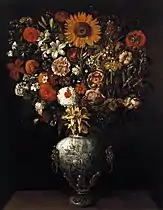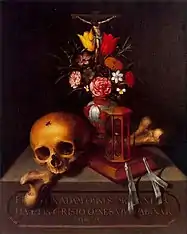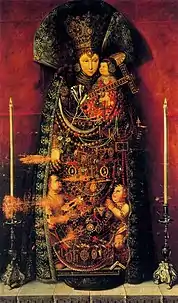Tomás Yepes
Tomás de Yepes or Hiepes (also known as Thomas de Yepes or Hiepes; 1595 or 1600 – 16 June 1674) was a Spanish painter in the Kingdom of Valencia. An artist of the Baroque movement, he worked as a painter of bodegón and still life. He made paintings both for clients and public events. Although his activity started in the second decade of the 17th century, the earliest works attributed to him come from 1642. He continued to paint until the year of his death.
Tomás Yepes | |
|---|---|
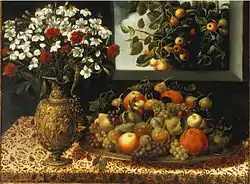 Naturaleza muerta (Still Life, 1645–50) by Yepes. He was prominent in the Kingdom of Valencia for his bodegón depictions of flower vases and fruits. | |
| Born | 1595 or 1600 |
| Died | 16 June 1674 (aged 78–79 or 73–74) |
| Resting place | Church of San Esteban |
| Nationality | Spanish |
| Known for | Painting |
| Movement | Bodegón, Baroque |
Yepes' depictions of flower vases, fruits, and everyday objects were prominent in the region during the 17th and 18th century, and he has been regarded as one of the major rediscoveries of art history. He is best known for his distinctive style of flower painting that he focused on throughout his career. His paintings are exhibited in museums and in private collections worldwide, with the Prado Museum, Madrid, hosting the most extensive collection of his works.
Personal life
Yepes was born to Pascual Tomás Yepes and Vicenta Pujades or Puchades in 1595 or 1600.[1][lower-alpha 1] Although biographers have been unable to ascertain whether he was born in the city of Valencia—where he was active during his career—he is considered to have been born in the Kingdom of Valencia.[1] He had an elder sister, Vicenta, who owned a confectionery. In 1631, she filed a lawsuit against Yepes demanding payment of old debts, which her brother settled with delivery of a few religious paintings.[8][9] Yepes was married to Ana Eres or Heres, a scion of a wealthy Valencian family; her family also owned properties that were rented out in Algemesí.[8][10] After the death of her brothers, Eres declared herself to be the sole heiress of the family on 4 July 1635.[10]
Career
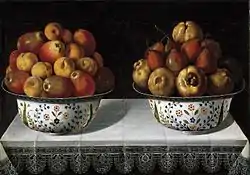
Not much is known about Yepes' life outside of his paintings.[11] He enrolled at the Colegio de Pintores de Valencia (College of Painters of Valencia) in October 1616.[8][12] By 1630, he was in a commercial agreement with Medina del Campo for business of his paintings at the town's various fairs.[13][14] According to his father-in-law and a carpenter at the fairs Gaspar Eres, Medina del Campo was in a contract of 220 Valencian pounds with Castile for trade and fairs, and Yepes' works were sold there.[10]
Besides his other works, Yepes also did paintings for clients.[15] In 1632, Yepes sold some of his fruit paintings for eight Valencian pounds to his notary Vicente Cortés.[16] On 4 December 1633, he signed a deal worth thirteen pounds and ten wages with the merchant Juan Ruiz for a supply of fabric and cloth to be used for his paintings with delibery by March 1634.[10] On 2 August 1638, Simón Colomer received eight canvases from Yepes, fulfilling an order Colomer had placed in 1637.[10]
William B. Jordan points to gaps in the timeline and life of Yepes; although he was active by the second decade of the 17th century, the earliest works attributed to him come from 1642: Frutero de Delft y dos floreros (Delft Fruit Bowl and Two Vases of Flowers) and Dos fruteros sobre una mesa (Two Fruit Bowls on a Table).[17] In 1655, his paintings were displayed in the Convent of Santo Domingo during the second centenary of the canonization of Saint Vincent Ferrer.[18][17] Yepes mainly chose to paint flower vases and fruits, for which he was known across the kingdom.[13][19]
Like Francisco Pérez Sierra, Yepes grew different varieties of flowers in his backyard to use for his paintings; Rincón de jardín con perrito (Garden Corner with a Dog, 1660s) is considered to be a portrait of his own garden.[20][21][22] He continued to paint through the 1660s; the Prado Museum's oldest Yepes work, Bodegón (Still Life) dates to 1668. His signed works have been found dated up to the year of his death.[23] Yepes died in Valencia on 16 June 1674, and was buried at the Church of San Esteband.[24][25]
Themes
Yepes specialised in painting bodegón and still lives.[25] His usage of contrast, detail, and deep colour belong to the Baroque style of painting.[26] He is noted for frequently painting flower vases, fruits, and everyday objects on tables and against landscapes.[25] Most of his paintings had underlying common themes: flowers in dark vases, fruits in porcelain bowls, and plain tablecloths sometimes with lace.[13] His works have been described as old-fashioned relative to contemporary artists in Madrid of that time. He employed symmetrical designs without much disruption in patterns, and his dim lighting and range of colours have been compared with that of Jerónimo Jacinto de Espinosa.[23] The earlier works have more attention to detail, while his later works exhibit a smoother composition.[27]
Yepes studied the works of Juan van der Hamen and some of his early paintings were similar to Hamen's style. Both employed symmetry of compositions, dark lighting, and highlighted the quality of objects by underlining their contours and applying multiple glazes. His paintings of sweets and desserts, such as Bodegón con dulces y frutos secos (Still Life with Sweets and Dried Fruit, 1650), draw a lot of parallels to Hamen's works with themes of lateral illumination, strong shadows, and symmetry.[28] His later works differed from Hamen's in that he introduced more variety of motifs, such as Manises ceramics in flower pots, Delft porcelain vases, rich branchy rugs, and landscapes.[29]
Yepes primarily focused on flower paintings throughout his life, which became a sub-genre of bodegón paintings. His depictions of flower vases are regarded to be distinctive in their style and incomparable to other bodegón painters of the time.[30][31] In Florero con cuadriga vista de perfil (Vase with Quadriga Profile View, 1643), he painted 26 species of flowers against a dark background, with a neutral vase and tablecloth to emphasize the colour and contrast of flowers.[32] In Florero con cuádriga vista de frente (Vase with Chariot seen from the Front, 1643), he painted flowers in a vase separated from each other to focus on individual flowers and their symmetry, instead of producing a cumulative effect.[31]
Yepes was notable for his depictions of grapes, which was a theme in early bodegón paintings: Paisaje con una vid (Landscape with a Vine, 1645), Bodegón de frutas (Fruit Still Life, 1650) and Bodegón con uvas (Still Life with Grapes, 1655).[27] His grape paintings shared themes with those of de Espinosa, Juan Fernández el Labrador, Francisco de Zurbarán, and Pedro de Camprobín. Marcos Antonio Orellana praised his grape depictions and said of one that "a basket full of grapes, whose diaphanous and transparent grains, with their branches, could deceive the birds, like those other highly celebrated Zeuxis grapes."[33]
Yepes painted in the vanitas genre; in Vanitas, he arranged a skull and a femur with a book, an hourglass, a bouquet of flowers and a crucifix, on a plinth with the inscription Et sicut in Adam omnes moriuntur ita et in Christo omnes vivificabuntur ("For as in Adam all die, so in Christ all will be made alive", I Corinthians 15:22).[34][35] Virgen de los desamparados (Virgin of the Forsaken, 1644), a religious work in horror vacui Baroque style is a trompe-l'œil of the venerated image on an altar between two candelabra. The altar is covered with jewels, reliquaries, rosaries, and painted miniatures.[3][36]
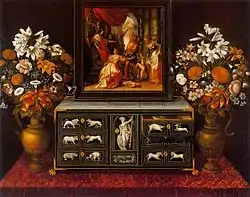
The influences of Flemish painting can be observed in some of Yepes' works, such as Cuatro macetas de flores en un jardín (Four Pots of Flowers in a Garden, 1663–64), which he painted in a more naturalistic and less ornamental manner.[37] He made use of the Flemish engravings of Jacob Binck in Bodegón con escritorio de ébano y floreros (Still Life with Ebony Desk and Vases, 1654) to depict Minerva.[38] Motifs of Levantine art can be observed in Bodegón (Still Life, 1668) with his depiction of oranges and lemons in a basket suspended in a corner, a roast bird, and a dragon-shaped empanada.[39]
Yepes also painted animal and human figures against landscapes, as seen in Rincón de jardín con perrito (Garden Corner with a Dog, 1660s) for the former, and Cazador bebiendo en un arroyo (Hunter Drinking in a Stream, 1650) and Cazador dormido en un paisaje (Hunter Asleep in a Landscape, 1650) for the latter—these two being his only works to feature human figures.[40][20][21] In Bodegón de aves y liebre (Still Life of Birds and Hare, 1643) he painted carcasses of birds of various species hanging in a symmetrical manner on both sides with a plucked hen in the middle, and viscera, sausages and eggs on the table—similar to the themes and composition of Jacopo da Empoli and Alejandro de Loarte.[41]
Works
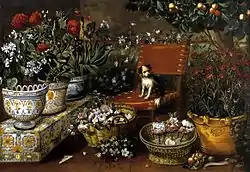
The Prado Museum in Madrid has the most extensive collection of Yepes' works, including bodegón works such as Bodegón de uvas (Still Life of Grapes, 1649), Bodegón de cocina (Kitchen Still Life, 1658), and Rincón de jardín con perrito (Garden Corner with a Dog, 1660s).[20][21] In 2006, seven more works were added to the museum from the private collection of Rosendo Naseiro, including his two earliest surviving works Frutero de Delft y dos floreros (Delft Fruit Bowl and Two Vases of Flowers, 1642) and Dos fruteros sobre una mesa (Two Fruit Bowls on a Table, 1642). Bodegón de aves y liebre (Still Life of Birds and Hare, 1643), Paisaje con una vid (Landscape with a Vine, 1645), and two other paintings of vases were also added from the Naseiro collection.[42][28]
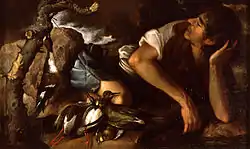
One of Yepes' many religious paintings is located at the Convent of Las Descalzas Reales, Madrid: Virgen de los desamparados (Virgin of the Forsaken, 1644).[36] His works preserved in the Museum of Fine Arts of Valencia include Bodegón con frutero de cerámica (Still Life with a Ceramic Fruit Bowl, 1650), Cazador bebiendo en un arroyo (Hunter Drinking in a Stream, 1650) and Cazador dormido en un paisaje (Hunter Asleep in a Landscape, 1650).[40][20]
The Fondation Raus pour le Tiers-Monde, Zurich, has two farmyard scenes: Pavo, perdiz y paloma en una terraza (Turkey, Partridge and Pigeon on a Terrace, 1649) and Gallo, gallina y polluelos (Rooster, Hen and Chicks, 1649).[43] Cuatro macetas de flores en un jardín (Four Pots of Flowers in a Garden, 1663–64), one of his works influenced by Flemish paintings is a part of the J. and D. de Menil Collection in Houston.[37] Many of his other works are in various museums and private collections worldwide.[11][44]
Legacy
Yepes was a prominent painter in Valencia during his lifetime, and he remained a notable figure of the kingdom into the 17th and 18th century.[11] He is regarded as the most important bodegón painter of the Baroque movement in Valencia.[23] Spanish writer Marco Antonio Ortí in his 1655 book said that Yepes had "acquired a very unique opinion and credit" in the kingdom.[13][19] However, he was only mentioned in a publication of wide circulation over a century after his death—in 1800, when Juan Agustín Ceán Bermúdez published his biographical dictionary of the prominent artists of Spain, Diccionario historico de los mas ilustres profesores de las Bellas Artes de Espana.[45][46]
Jordan summarized that "Yepes was greatly admired in his own day and has been a major rediscovery of our time."[47] Spanish art historian Alfonso E. Pérez Sánchez organized an exhibition of Yepes' works at the Centre Cultural Bancaixa, Valencia, in 1995. The catalogue included archival research performed by Spanish art historian Benito Navarrete Prieto which contributed to the existing knowledge of Yepes' life and works.[17] Jordan commented that the "exhibition demonstrated that not only is Yepes one of the most skilled and exquisite of painters, but maintained the interest of his patrons and collectors with his expertise in flower painting and a range of different still-life types."[47]
Notes
- Some sources mention 1595,[2][3] while others mention 1600.[4][5] His birth year was also suggested to be 1610.[6][7] However, William B. Jordan in his 1997 book notes that "in October of 1616, the young Tomás Hiepes was admitted to the Colegio de Pintores in Valencia, an indication that his birth must have been around 1600, or probably even a few years before, instead of around 1610, as previously supposed."[8]
References
Citations
- Sánchez & Prieto 1995, p. 142.
- Ramírez 2009, p. 84.
- Autores et al. 2018, pp. 50–51.
- Witt Library 2014, p. 551.
- Varey & Chabrán 2000, p. 151.
- G. K. Hall 1993, p. 156.
- Matthiesen Fine Art 1993, p. 87.
- Jordan 1997, p. 110.
- Sánchez & Prieto 1995, pp. 144–146.
- Sánchez & Prieto 1995, p. 146.
- Sánchez & Prieto 1995, pp. 140–142.
- Sánchez & Prieto 1995, p. 16.
- Alós 2009, p. 56.
- Stratton-Pruitt et al. 2002, p. 191.
- Luna 2008, p. 76.
- Prado & Bilbao 2000, p. 281.
- Jordan 1997, p. 115.
- Williams 1907, p. 229.
- Sánchez & Prieto 1995, p. 147.
- Scheffler 2000, pp. 571–581.
- Sánchez & Prieto 1995, pp. 145–154.
- Luna 2008, pp. 80–81.
- Prado 2020.
- Sánchez & Prieto 1995, p. 141.
- Maxwell 1891, p. 766.
- Serventi 2004, p. 123.
- Sánchez & Prado 2006, p. 68.
- Sánchez & Prieto 1995, p. 151.
- Sánchez & Prieto 1995, pp. 150–155.
- Luna 2008, pp. 78–79.
- Sánchez & Prado 2006, pp. 64–65.
- Luna 2008, p. 78.
- Sánchez & Prieto 1995, pp. 58–59.
- Valdivieso 2002, p. 102.
- Sánchez & Prieto 1995, p. 159.
- Museum of New Mexico et al. 1992, p. 18.
- Sterling 1981, p. 20.
- Sánchez & Prieto 1995, p. 26.
- Prado 2016.
- Sánchez & Prieto 1995, p. 149.
- Sánchez & Prado 2006, p. 66.
- Alós 2009, pp. 56–58.
- Sánchez & Prieto 1995, pp. 68–70.
- Bryan 1816, p. 627.
- Sánchez & Prieto 1995, pp. 140–141.
- Bermúdez 1800, p. 71.
- Caylus & Rafael Valls Limited 2004, pp. 5–6.
Sources
- Alfonso E. Pérez Sánchez; Benito Navarrete Prieto (1995). Alfonso E. Pérez Sánchez (ed.). Thomas Yepes (illustrated ed.). Fundación Bancaja. ISBN 9788488715210.
- William B. Jordan (1997). An Eye on Nature: Spanish Still-life Paintings from Sanchez Cotan to Goya (2, illustrated ed.). Matthiesen Fine Art. ISBN 978-88-422-0758-0.
- William Stirling Maxwell (1891). Robert Guy (ed.). Annals of the Artists of Spain. 2. J. C. Nimmo.
- Jaume Mercant i Ramírez (2009). La farmàcia monàstica de la Reial Cartoixa de Valldemossa (Mallorca) (in Spanish). Illustrated by Jaume Gual. J.J. de Olañeta. ISBN 978-84-9716-663-8.
- Simon Varey; Rafael Chabrán (2000). Dora B. Weiner (ed.). Searching for the Secrets of Nature: The Life and Works of Dr. Francisco Hernández. Stanford University Press. ISBN 978-0-8047-3964-1.
- Witt Library (2014). Checklist of Painters from 1200-1994 (2 ed.). Routledge. ISBN 978-1-134-26406-3.
- Matthiesen Fine Art (1993). Fifty Paintings 1535-1825: To Celebrate Ten Years of Collaboration Between the Matthiesen Gallery, London and Stair Sainty Matthiesen, New York. Matthiesen Fine Art. ISBN 978-0-9522353-0-9.
- Spanish Artists from the Fourth to the Twentieth Century: A Critical Dictionary. 1–3. G. K. Hall. 1993. ISBN 978-0-7838-8037-2.
- Michael Bryan (1816). A Biographical and Critical Dictionary of Painters and Engravers. 2. Carpenter and Son; J. Booker; and Whittingham and Arliss.
- Varios Autores; Silvia Spitta; Valeria Wagner (2018). Adriana López-Labourdette (ed.). Des/memorias. 200. Linkgua. ISBN 978-84-9007-526-5.
- Enrique Valdivieso (2002). Vanidades y desengaños en la pintura española del Siglo de Oro (in Spanish). Fundación de Apoyo a la Historia del Arte Hispánico. ISBN 978-84-932891-0-2.
- Museum of New Mexico; Archaeological Society of New Mexico; School of American Research (1992). El Palacio. 97–99. Museum of New Mexico.
- Felix Scheffler (2000). Das spanische Stilleben des 17. Jahrhunderts: Theorie, Genese und Entfaltung einer neuen Bildgattung (in German). Vervuert. ISBN 978-3-89354-515-5.
- Vicente Pons Alós (2009). Felipe Vicente Garín Llombart; Vicente Pons Alós (eds.). La gloria del barroco: Valencia 2009-10 : catálogo (in Spanish). Generalitat Valenciana. ISBN 9788448253448.
- Juan Agustín Ceán Bermúdez (1800). Diccionario histórico de los más ilustres profesores de las bellas artes en España (in Spanish). En la Imprenta de la Viuda de Ibarra.
- Museo Nacional de Bellas Artes; María Cristina Serventi (2004). Spanish Painting (from the XVIth to the XVIIIth Century) at the National Museum of Fine Arts. Asociación Amigos del Museo Nacional de Bellas Artes. ISBN 978-987-20097-6-2.
- Leonard Williams (1907). The Arts and Crafts of Older Spain: Textile fabrics. T.N. Foulis.
- Charles Sterling (1981). Still Life Painting: From Antiquity to the Twentieth Century (2 ed.). Harper & Row. ISBN 978-0-06-438530-5.
- Suzanne L. Stratton-Pruitt; Jonathan Brown; Bartolomé Esteban Murillo (2002). Bartolomé Esteban Murillo (1617-1682): Paintings from American Collections. Illustrated by Bartolomé Esteban Murillo. Harry N. Abrams. ISBN 978-0-912804-38-5.
- Museo del Prado. Amigos; Museo de Bellas Artes de Bilbao (2000). El Bodegón (in Spanish). Galaxia Gutenberg. ISBN 9788422684749.
- Rafael Valls Limited; Caylus (2004). "El Bodegón" An Exhibition: Spanish Still Life Painting from the 17th to the 19th Century (PDF). Madrid: Caylus. Archived from the original (PDF) on 28 May 2020.
- J. R. S. P. "Hiepes, Tomás". museodelprado.es (in Spanish). Madrid: The Prado Museum. Archived from the original on 27 August 2020. Retrieved 27 August 2020.
- J. J. Luna (2008). El bodegón español en el Prado (in Spanish). Madrid: The Prado Museum. ISBN 9788484801580.
- Alfonso E. Pérez Sánchez; Museo Nacional del Prado (2006). Javier Portús Pérez (ed.). Lo fingido verdadero: bodegones españoles de la colección Naseiro adquiridos para el Prado (in Spanish). 5. Museo Nacional del Prado. ISBN 978-84-8480-097-2.
- Museo Nacional del Prado (2016). Los objetos hablan (in Spanish). Madrid: Museo Nacional del Prado.
External links
 Media related to Tomás Yepes at Wikimedia Commons
Media related to Tomás Yepes at Wikimedia Commons
